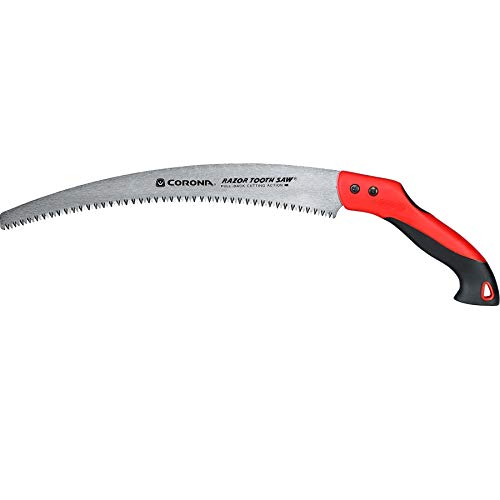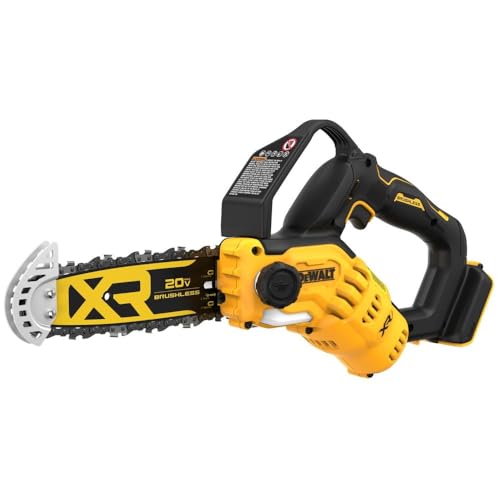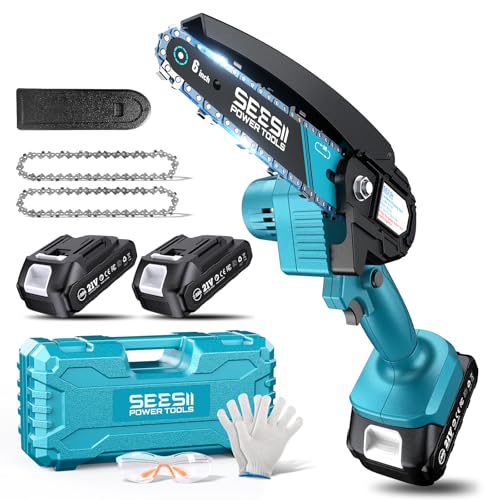The Best Pruning Saw

To help you find the perfect pruning saw, we continuously put forth the effort to update and expand our list of recommendable pruning saws. Our team collects, edits and publishes new information, in order to present it to you in an accurate, significant and neatly arranged way.
Our Picks
8 More Pruning Saw Alternatives
Table of Contents
Buying Guide
Why You Need a Pruning Saw
Any gardener without a pruning saw who has learned they need one has probably had this one thing happen to them. A stinging hand, sore fingers, and wanting to cuss out the branch, the small pruning shears, and whosever idea it was to prune the trees and shrubs today. Or else you are being bothered by that one branch that is ever so slightly out of reach, which is ruining the perfect shape of your plants, but you cannot get to with the tools in your gardener’s shed right now.
If either of those scenarios sound familiar, then welcome. You are going to want to keep reading because we are about to review the best pruning saws for your home or commercial landscape needs.
Basically, a pruning saw is a different type of saw with a secure handle that has either a very sharp straight blade or a curved blade. It is used for the toughest trees and hard to reach braches that other pruning tools cannot cover. That makes it very useful for both home and commercial gardening projects. With so many different kinds and options out there, you may also be asking yourself which is the best one for you.
Once that’s covered, you will then need to decide which is the best type of pruning saw for you. There are a few basic types of there.
Handheld Pruning Saw—Curved
Curved pruning saws are the most commonly seen types out there online. They are great if you are dealing with tough jobs as their curved blades allow you to saw through wood with the ease of slicing cake. However, they are best for smaller branches. When you try cutting large branches with a handheld curved blade, some people find it difficult to maneuver and prefer a straight cut.
Handheld Pruning Saw—Straight Blade
A straight blade pruning saw is exactly as its name describes, but the handle is normally curved for a more ergonomic grip. These are less effective at older, tougher wood cuts than a curved blade, but work great for green wood, saplings, and softer cuts on large branches.
Pole Saw
The poles in a pole saw are often sold with both straight and curved blade attachments. They will be a blessing for anyone whose tall tree projects usually would require a ladder or if you are making deep pruning cuts. They allow you to keep both feet firmly on the ground for safety, and normally telescope to different lengths so you can get exactly the cut you need. Before buying one, however, you will want to remember that they are usually heavy and many times you will need to tug on a rope to make the cuts, to compensate for the loss of leverage for an 8-foot pole versus something handheld.
Folding Pruning Saws
Many of the pruning saws, including several that we list here, fold up when not in use. We know not everyone has unlimited space in the garden shed, and having something that folds up into a smaller size can help with storage. It also is safer is there are small children, as they are less likely to accidentally be cut while running or playing in the garage. Some people even take them camping and use them to cut firewood and clear brush during a hike. The main thing to pay attention to is the locking mechanism. If it is not sturdy and firm it can come undone during a cut, adding to the time and frustration of your pruning project.
Using a Pruning Saw
Primarily, a pruning saw is used for cutting back branches on trees when the job is too tough for a regular pruning shears. It also can have health benefits for your landscape. When a tree has a diseased or sick branch, you will need to take quick action and pruning saws work well for larger branches and hard to reach heights.
Size matters. Most pruning saws are designed for branches between one and three inches in diameter. Larger branches typically work better with a straight saw than a curved blade. And if you are using a pole pruner, keep the weight of the apparatus in mind so you don’t tweak your back and avoid tangling the line. Depending on the type of project, you will want a different length for your blade. Smaller blades will allow you to go into more spaces, but take longer to get the job done, while longer blades will cut faster but may become entangled in multiple branches.
Safety is also important. It is highly recommended that you use safety goggles and gloves. To keep the weight of the branch from dragging down bark and harming the tree, you should use shears to cut off the smaller branches, then cut with the pruning saw. Whenever possible, cut downward through the branch, not upward, and cut a groove in the branch before you begin pruning.
Choosing the Right Pruning Saw for You
Excellent. You’ve gotten this far and you know roughly which kind of pruning saw you are going to need. Now how you do pick the best of the bunch? Here are a few recommendations.
Best Pole: The Fiskars 7-14 Foot Power-Lever Extendable Pole Saw & Pruner has clearly dominated the extendable pole pruner market. It telescopes anywhere from 7-14 feet, allowing you to reach high branches and prune with ease. Its main drawbacks are its weight, which can be a struggle if you are not used to it, and keeping the line smooth and in place while jiggling the saw on the end.
Best Straight: The Tabor Tools 10-inch pruning saw comes with a safety sheath included, doubling the value for its price. It is powerful enough to slice through a 4-inch tree branch, but lightweight enough to carry with you when camping or doing landscape work around the yard. The non-slip, pistol-grip handle is a great safety feature, and will keep your hands comfortable and the pruning fun.
Best Curved: The Corona RS 7265D is highly recommended by many expert landscapers and gardeners. Even though it folds closed, it is sturdy and strong enough to cut through dense wood, and weighs less than a pound so it is easy to use regardless of your personal muscle tone. The double-cut, on both a push and a pull stroke, definitely makes a difference when it comes to speeding up your pruning projects.
Top Rated Pruning Saws
If you're looking into finding the best rated pruning saw, you should probable check out the Corona Tools 14-Inch RazorTOOTH Saw. We looked at various sources of reviews and found this one to have the best mix between review count and average rating stars.
The Lowest Price We Could Find
Often, going for the best price is a simple but good option. With a price of $12.69 (last checked this morning), we do not list any other pruning saw cheaper than the HURRICANE Folding Saw/10 Inch Implement/Wood-Cutting Gear/Camping Tree Cutter with SK5 Curved Blade/Triple-cut Razor Teeth/Outdoor Portable Cutter for Tree Trimming Gardening Hiking. Just remember that it's not always the best option to go for the cheapest one.
The Pruning Saw With the Most Reviews
With at least 257 reviews and counting, the Corona Tools 14-Inch RazorTOOTH Saw might be another option to consider. This large amount of reviews signalizes that many people are using it, with most of them beeing satisfied.
High Quality Pruning Saws
It's quite rare that the saying "You get what you pay for" turns out incorrect. If you have the money on the sideline, feel free to choose the most expensive item from our list: The Dewalt Chainsaw CRDLS 20V 8IN DCCS623B currently sells for $177.20.
The Pruning Saw With the Most Clicks
If you trust us and our users, feel free to check out the Corona Tools 13-Inch RazorTOOTH Saw. Our statistics say that it is the most favorite Pruning Saw from the list above.
Our Bestseller
If you're still undecided, I would recommend that you go with the masses and choose the top selling pruning saw: The Seesii Mini Chainsaw is the hottest bestseller in this category right now.
Pruning Saw Reviews
Further Reading on Pruning Saws
Research
long and having finer teeth; Plywood saw : a fine-toothed saw (to reduce tearing), for cutting plywood; Pruning saw : the commonest variety has a 12-28 inch
A portable powered pruning saw including a power housing having a powered rotatable output shaft; a saw housing having a motion converting mechanism with a rotatable input shaft and a reciprocating output element, and a saw blade reciprocated by the output …
A pruning saw includes an elongated sawblade which has a line of cutting teeth. Opposite sides of the blade extending between the line of teeth and the back edge are concave. A thinnest waist between the concave sides is located closer to the line of teeth than to the …
Another novel characteristic of the inven tion may be stated to reside in the provision of means for rigidly securing the pruning saw proper in its extended or operative posi tion with respect to the handle therefor, such means being of a construction whereby they may be …
Useful Videos
Samurai Pruning Saws. ( review / test cuts ) samurai GC-240-LH (green/red handle) samurai C-330-LH (red/black handle) Silky zubat equivalent, Please like ...
Comments
About this Article
It was last updated on 2025-12-14 08:26:15 and has been viewed 3721 times.




